Visited the Chief (2006, 10/25)
Recorded by: Hsiao-ning
Today teacher arranged us to start visiting tribal chief. We seven gathered with classmates of B group at the library after school and teacher told us to watch our manners this afternoon because we were going to visit a big chief and roughly told us about the importance of the Paiwan Village for the Paiwan Tribe. We took our stuff and rode separately in four teachers’ cars heading to the appointment.
 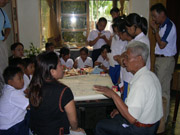
Teachers parked their cars at the Village Activity Center. We walked a few minutes to the home of Chief Auntie. Outside her house, there was a big stone monument carved with aboriginal designs. We went into the house quietly and were treated so well. Teachers told her our intention of visit and all fourteen of us introduced our names and clans’ names in mother tongue. We were so nervous and stuttered. I felt we should be able to do much better next time. We understood a lot of things as Chief Auntie and Vuvu explained, including the ancient location of the Paiwan Village, Chief’s clans and legendary tales. I was angry with myself that I wrote too slowly and could not take them all down. But Auntie allowed us to come again next week and teacher would bring a recording pen to record. I really expected next week to come soon. We said goodbye to Auntie and VuVu and teacher sent us home. We completed a wonderful visit today.
Visited Chief again in fine dress (2006, 11/01)
Recorded by: Hsiao-ning
Last week, teacher made an appointment with Chief Hsiao that we would visit Qapulu Chief today. We followed the aboriginal rites and customs to put on fine dress and bring a whole bag of betel nuts and leaves as gift to set off.
 
We had to yell, “We are coming for a visit.” when we reached the open ground in front of the Chief’s house. Chief and elders would come to the doorway to welcome us with water, so every one of us accepted a cup of water as gift. We entered the house and sat down orderly, then I was chosen to report our intention of visit and present them our gifts. Chief and elders made welcome speeches, and then came the part that we liked the most – the candies and cookies that auntie prepared for us. Then we started the interview. Chief Hsiao told us about chief’s decorations, from the level of Hawk-Eagle features put on heads to lazurite ball necklaces whether it was a single string or a bundle of strings. For men, necklace decoration was a bundle of four strings and for women, it was a bundle of three strings. Then we talked about the ancient precious pottery of auntie’s. Its age was unable to tell. We were so careful when it was taken out. There was damage at the mouth part, which was made intentionally in order to distinguish who its owner was. Also we talked about the tattoos of Paiwan Tribe and the chief badge during the Japanese occupation. There was tons of information that I could not write down. Luckily, teacher prepared a recording pen to record the interview and Director Shih also filmed the whole event. We appreciated Chief Hsiao and Nanny Chin to teach us so many traditional aboriginal rites and customs that we could not learn from school. This was such a meaningful afternoon. We took a photo together and ended the visit today. Yeah! Such a success!
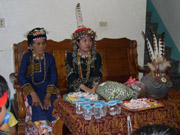 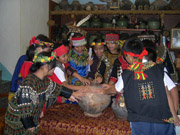
Visited my great grandmother (2006, 11/08)
Recorded by: Hsiao-ning
Teacher kept asking me since last week to ask my mother whether we could interview my great grandmother. Through my mother’s contact, my great grandmother agreed our visit right away. Yesterday noon, teacher gathered us at the computer room to tell us about the schedule and main points of the visit and asked us to search for some information regarding aboriginal tattoos from the Internet. I found that women of Paiwan Tribe had the custom of hand tattoo before the age of 17~18. The pattern included diamond, straight line, twisted lines and human shape, each with its special meaning. Such custom was prohibited when the Japanese came. We had all done our basic homework.
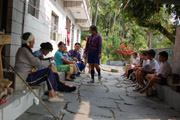 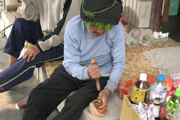
Today we gathered at 12:30 right after school. My father’s car led the way and we set off to that remote Dashe Village. We passed the Sandimen Village and entered the mountain area. We went straight after passing the checkpoint and were on our way to the Dashe Village. The car tilted this way and that way with flying dusts all over. We passed the Tewen Village and before we were to vomit, we finally came to the most inward Dashe Village. I had been here many times, but this was the first time I came with teacher and schoolmates. My great grandmother sat under the eaves to accept our interview and my mother was the interpreter. Talking about the long gone past in 1990, my great grandmother was still very excited. It seemed she was talking about something just happened yesterday. I hadn’t seen her being so happy for a long time. We knew then that there were only three people left in the tribe who had hand tattoos. We also got to know who could have hand tattoos, the reason why and what taboos there were. Mother told me that there were also many things for her to know for the first time. So, the fact about the past history and culture really depended on our continuous exploration and recording. We had to say goodbye to great grandmother as night fell. I wished great grandmother to be forever healthy as there were still many many inheritances we needed her to tell us.
Visited Gao’s family of Daugudu in the Paiwan Village (2006, 11/15)
Recorded by: Hsiao-rong
At school, teacher told us about the chief families of the Paiwan Village that was recorded in books. Chief in Paiwan Tribe is inherited from generation to generation and the heir gets the title no matter male or female. Currently in the Paiwan Village, there are three chief families. Among them, the Gao’s family of Daugudu that we are going to visit today has the highest rank. The highest rank refers to a status that is recognized by the entire Paiwan society. Some of the chiefs do not come from chief families originally, but are connected slowly through marriages. After teacher’s explanation, we rode in three cars separately and set off to the Paiwan Village.
We got off at the Activity Center and brought with us the betel nuts gift that teacher prepared. Although teacher said we must not chew betel nuts, in the aboriginal society, betel nuts are a must gift when visiting chiefs. We arrived at Gao’s family of Daugudu and saw a large stone-carved qaris. The feather on the chief’s head is its feather. Teacher told us that its accurate name should be Hodgson's Hawk-Eagle or Hawk-Eagle, Mountain Hawk-Eagle, the largest raptor in Taiwan. We sat down and I represented the whole group to present our gift. I had to say who I was first, my family name and which village I came from. I also explained that we were students from the Jiayi Elementary School and came to interview chief because we attended the Cyberfair Contest. I thanked chief to accept our interview. Chief made a welcome speech and then the interview started.
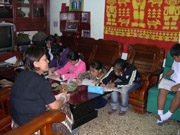 
The master of Gao’s family of Daugudu had passed away, so currently his daughter Guan-fen Gao (Zuljzulj) took over the title. Since she is still young (26 years old), she knew little about the family business. So her mother, Mrs. Yu-gui Lin (Maljeveljev) accepted our interview instead. Since her father-in-law left the Old Paiwan Village long ago to work as a policeman at Taoyuan Township of Kaohsiung County and left the house to be taken care of by others, some ancient pottery were all gone due to poor management. There wasn’t any ancient pottery left at the moment. All potteries in the cabinet are marriage gifts from villagers. We also knew that the six chief families publicly recognized in the Paiwan Tribe were: Daugudu’s family of Paiwan, Lai’s family of Dashe Village Taljimarau, Hsu’s family of Majia Village Vavulengan, Pan’s family of Taiwu Village Karagiyang, Luo’s family of Gulou Village Dilevagan, Gao’s family of Taitung Giring; Gao’s family of Daugudu must receive presents of potteries and two pigs for marriage while other chief only received one pig as present. Mrs. Lin had been very enthusiastic and told us a lot of things. We left Gao’s family of Daugudu happily and took a photo in front of its stone monument.
Visited the House of Chen’s family of Paiwan Village Mavaliu (2006, 11/16)
Recorded by: Hsiao-wen
Teacher told us that we were a little bit slow on our progress of the interview, so following the visit of yesterday, we were arranged to visit another chief’s home today - Chen’s family of Paiwan Village Mavaliu. Teacher told us at noon recess that Mavaliu family was a military leader in the tribe, responsible for defending external aggression and fighting arrangement. Suddenly, we felt that teacher seemed more and more like an elder in the tribe who knew many tribal past. We really needed to catch up.
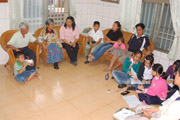 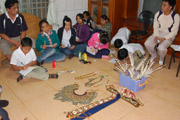
As usual, we got off at the Activity Center and brought the presents – betel nuts with us. Today it was the turn of Hui-ru to report our intention of visit. Hui-ru was rather shy and did not explain our intention clear enough. Teacher might have some opinions about this when we backed to the school. The original chief of Mavaliu family had passed away and his first-born son Chi-long Chen (Lauchu) took over the title. Because he was still young, a 78-year old elder Hsian-ren Jin in the Paiwan Village was invited in particular to help explain the past stories. Also his mother Mrs. Chao-yin Chen (Vavoni) was there to tell us the most realistic and accurate history. Through interview, we knew that if any defending or fighting business occurred in the tribe, people must gather at Mavaliu family to discuss before setting off. The Mavaliu family also took charge of the Youth Hub. In the Paiwan society, the Youth Hub is similar to a military obligation. Young men, from 18 years old before getting married, have to bring their weapons with them and live in the Hub for training. If they want to attend any ceremony such as marriage or funeral, they have to gather here before they set off. If they hunt any human head, they have to bring it here at the open ground, throw the head into the air and catch it with a spear (similar to stabbing a Lucky Ball), and then place it on the head shelf in the tribe. We also talked about a pottery in Mavaliu family. When Japanese people came and wanted to take it away, to everyone’s surprise, the pottery shed tears. But it was taken away anyhow. These seniors all spoke in mother tongue. We had to rely on interpretation in order to take notes. We really need to learn our mother tongue better; otherwise a lot of things may not be able to pass down.
Finally, Chief took out a family heirloom – a lazurite ball that fumed when shined by the sun. It was mounted at Chief’s head decoration. It was a cloudy day today and the ball did not fume when teacher took it outside to take a photo. I was really curious to know whether it would fume or not, or whether the ball might shrink when it fumed. Teacher reminded us to watch manners, so I might just ask next time when I got the chance. I had a full load of records to be arranged back home. Finally, we took a group photo with Chief’s family members in front of the house. I wanted to mention the wooden sculpture in front of the house. It had an apron to cover its lower body. It is the most polite wooden sculpture that I have ever seen.
Visited Nose Flute Master Grandpa Jin (2006, 11/23)
Recorded by: Hsiao-rong
The nose flute interview was scheduled for yesterday afternoon, but since we went to the Old Paiwan, the interview was postponed to today. We finished our lunch and set off in cars when other classmates were taking their noon nap. We got off at the Village Activity Center and saw Grandpa Jin waving at us from afar. We entered his home and saw many tools on the table including knifes, chisels, tools for drilling holes and some other self-made tools that I did not know how to describe. I guessed Grandpa Jin would teach us how to use these tools later.
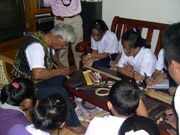 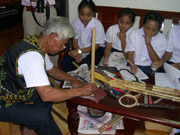
Grandpa Jin explained that there were single-pipe flute and double-pipe flute. Only warriors can blow a single-pipe flute. As to double-pipe flute, both nobles and civilians can blow. It can be used to court beloved women. When a man blows a song in front of a woman’s house, if the woman is interested, she will open up the window. This was what I understood but it might not be exactly the meaning since Grandpa Jin spoke in mother tongue and was interpreted by Teacher Cho. Then we were taught that there were only two kinds of bamboos with longer knots that could be used to make nose flutes. Rub the bamboo first, then drill sound holes and make a mouthpiece by cutting a wooden sieve just large enough to fit into the slot carved on the bamboo. If satisfied after having a few trial blows, use a drill burnt in red to drill three holes as traditional version and five holes as improvement version. No holes are drilled for the other pipe. Bind these two pipes together and it is done. Grandpa Jin tried to blow a song using the newly finished nose flute. Maybe because it was done too quickly, the effect was not satisfactory. He took out another nose flute of his and blew a song. The sound of a nose flute originates from Hundred-pace Snake. It sounds rather sad and like crying when we hear it at night. His granddaughter is also a member of the school’s team that attends the Cyberfair Contest. She performed for us and it really sounded good. We passed around the nose flutes and took a photo with everyone blowing a flute. We said goodbye with appreciations and hoped nose flutes could pass down to generations forever.
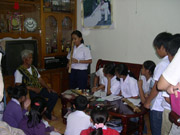
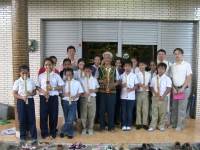
Visited beautiful Chief (2006, 11/24)
Recorded by: Hsiao-wen
At the recess of the second class, teacher gathered us unexpectedly saying that we would go to the Paiwan Village to see Chief in the Daugudu family. Last time when we were there, we only saw her mother. Teacher contacted the family again and made sure that she would be dressed in splendid attire to accept our interview at 10:30 this morning. I heard from classmates that she was very beautiful with very pretty feathers on her head. I couldn’t wait to see if it’s true.
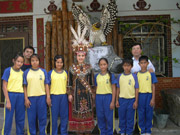

We rode in two separate cars. We heard the pleasing jingle sounds from aboriginal attire when we arrived at Chief’s home. Chief’s mother welcomed us full of smiles. When we entered the house, we found something different from our last visit. All the potteries in the cabinet were hanged with strings of lazurite balls. On the corner of the living room, the present when Chief got married was on display. There were two big potteries with delicate decorations, two hanging strings of lazurite balls and three Hawk-Eagle feathers symbolizing the status of a big chief on the mouths of the potteries. Two aboriginal spears with feathers stood beside them. (Teacher Cho explained that spears for decoration purpose and for hunting were different. The hunting spear had a knife bounded on a long wooden pole.) Chief’s mother also showed us a special pottery that a Hundred-pace Snake crawled out of its mouth. This was the first time I saw.
Finally, beautiful Chief appeared. We were all amazed, including teachers of course, by her charm with smiles and astonishing aboriginal attire (her wedding gown, said to be over one hundred thousand dollars). We took photos outside. From group photos to Chief’s individual photos, we saw Director Shih clicking the camera one after another. He took over sixty photos for her face close-up alone. I thought the photos would be enough for having a personal gallery show. But Chief was still smiling and she had a group photo with us in front of the monument. Chief’s mother explained to us the stories behind the patterns of the beautiful aboriginal embroidery on the clothes. They included having a swing, carrying potteries, mountain boars, etc. We ended this pleasant visit with Chief and her family members’ warm goodbye.
 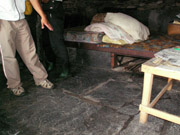
Visited a senior in the tribe (2006, 01/10)
Recorded by: Hsiao-ning
Judy Grandpa Hsu, a senior in the tribe, had been living happily on the mountain in a self-sufficiency way. Twenty years ago, less than fifteen people lived permanently on the mountain. They were having casual life planting millet, taros, and vegetables, hunting animals and raising sheep. Only a few years ago when electricity was provided did they have the light. Teacher told us,“The precious part about seniors is that their experiences cannot be bought by money no matter how much. Their wrinkles on the face are traces of time, representing wisdoms being put on days after days and years after years.” I was so touched when I heard this and let me think of my great grandmother. I must find some time to go up to the mountain to chat with her. From his conversation with teacher, we understood more things about the tribal relocation and we knew that a small part of people from the Tusantaf tribe located above the relics of the Fawan Elementary School followed their chief who worked as a policeman and moved to Taoyuan Township of Kaohsiung County after restoration, and rest of the people moved to the tribe in the lower part. Thus those slate houses were abandoned. We deeply know that without records, those past events can never be traced back afterwards.
 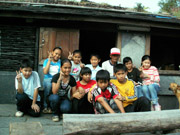
Top |
